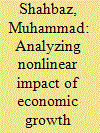|
|
|
Sort Order |
|
|
|
Items / Page
|
|
|
|
|
|
|
| Srl | Item |
| 1 |
ID:
176111


|
|
|
|
|
| Summary/Abstract |
Several Asian countries are facing challenges regarding the accomplishment of the objectives of Sustainable Development Goals (SDGs), and India is facing a similar situation. Following this, this study talks about designing an SDG framework for India, which can be used as a benchmark for other Asian countries. In this pursuit, this study looks into whether per capita income, energy use, trade openness, and oil price have any impact on CO2 emissions between 1980 and 2019. The nonlinear autoregressive distributed lag approach proves that the fluctuations in independent variables have an asymmetric long-term impact on CO2 emissions. The results reveal that the prevailing economic growth pattern in India is environmentally unsustainable, because of its dependence on fossil fuel-based energy consumption and imported crude oil. Import substitution has been identified as one of the first stepping stones to address this issue, and accordingly, a multipronged SDG framework has been designed based on the direct and extended version of the study outcomes. While the Central policy framework shows a way to address SDG 7, SDG 8, SDG 12, and SDG 13, the Tangential policy framework shows the way to sustain the Central policy framework by addressing SDG 4.
|
|
|
|
|
|
|
|
|
|
|
|
|
|
|
|
| 2 |
ID:
180124


|
|
|
|
|
| Summary/Abstract |
Under the double-track price system, alternative energy prices and the spread between liquefied natural gas and pipeline natural gas have created a supply-demand imbalance in China's natural gas market, which poses potential risks to economic development and industrial safety. Based on alternative energy prices, economic development level, and geopolitics, this paper used NARDL (Nonlinear Autoregressive Distributed Lag Model, NARDL) to analyze the effect of the spread on the imbalance in the natural gas market. It was shown that the spread and economic development level had a significant impact on the imbalance. Oil prices and geopolitics didn't have a significant impact in the short term while rising coal prices could alleviate the imbalance. Also, the imbalance and the spread in the natural gas market were likely to form a vicious cycle of mutual increase in the short term. Moreover, the impulse response results showed that the impact intensity of the spread on the natural gas market was greater under the background of “short supply” in 2017. Accordingly, a new pricing policy should be aimed at promoting the market-oriented reform, establishing an asymmetric price adjustment mechanism, and guiding rational consumption.
|
|
|
|
|
|
|
|
|
|
|
|
|
|
|
|
|
|
|
|
|